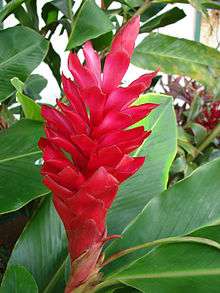Zingiberales
| Zingiberales Temporal range: 80 Ma Late Cretaceous - Recent | |
|---|---|
 | |
| Alpinia purpurata, a popular ornamental of the Zingiberaceae. | |
| Scientific classification | |
| Kingdom: | Plantae |
| Clade: | Angiosperms |
| Clade: | Monocots |
| Clade: | Commelinids |
| Order: | Zingiberales Griseb. |
The Zingiberales are an order of flowering plants. The order has been widely recognised, at least for the past few decades, and includes many familiar plants, such as ginger, cardamom, turmeric, galangal and myoga in the Zingiberaceae or ginger family, bananas and plantains in the Musaceae or banana family, arrowroot in the Marantaceae or arrowroot family, Ravenala, Phenakospermum and Bird of Paradise flower in the Strelitziaceae family, along with various types of heliconias in the Heliconiaceae family. Its families are grouped in two morphological groups, based on the number of fertile stamens, a paraphyletic basal assemblage of "banana-families" with 5 or 6 fertile stamens (Musaceae, Strelitziaceae, Lowiaceae, Heliconiaceae), and a derived clade of "ginger-families" with only one fertile stamen and four or five highly modified staminodia (Zingiberaceae, Costaceae, Cannaceae, Marantaceae).[1]
The common ancestor of the Zingiberales is estimated to have originated 158 million years ago with six of the eight families established by the end of the Cretaceous,[1] but Stevens on the APWeb lists a number of papers that date variously the stem and crown groups age.[2] Probably the ancestral Zingiberales were distributed in tropical Gondwanaland encompassing the present day Americas, Africa, and Southeast Asia with subsequent dispersals between Africa and the Americas; the current distribution of the Zingiberales seems to be a product of numerous secondary and tertiary dispersal events between the major tropical regions of the world.[1] The phylogenetic diversification and biogeographic dispersal of the Zingiberales was in part driven by the evolutionary radiation and diversification of their associated animal pollinators, which include bats, birds, non-flying mammals, and insects.[1] Six of the eight families of the Zingiberales contain taxa specialized for pollination by vertebrates, which appears to be the plesiomorphic state in the order.[1] Of these six families two are exclusively vertebrate-pollinated (Strelitziaceae, Heliconiaceae).[1] Pollination by insects also occurs in six families with one (Marantaceae) or possibly two (Lowiaceae) families predominantly specialized for insect visitors. (Kress and Specht 2005[1])
Species of the Zingiberales order, together with those of the Commelinales order, are thought to have evolved around 80 million years ago during the Late Cretaceous.
Taxonomy
Earlier systems, such as the Wettstein system, last revised in 1935, and the Engler system, updated in 1964, recognised a similar order (containing the same plants, although divided over fewer families), the Scitamineae. The Cronquist system also recognised this order with eight families, but organized the order in the subclass Zingiberidae of the class Liliopsida (monocotyledons). In the classification system of Dahlgren the Zingiberales were the sole order in the superorder Zingiberiflorae (also called Zingiberanae), with the sam eight families.
The APG III system, of 2009, and the APG II system (2003) recognize this order and assign it to the clade commelinids, in the monocots. The family structure was kept from the earlier systems, and is circumscribed as:
- order Zingiberales
- family Cannaceae (e.g. Canna)
- family Costaceae (e.g. Costus, spiral ginger)
- family Heliconiaceae (e.g. Heliconia)
- family Lowiaceae (e.g. Orchidantha)
- family Marantaceae (e.g. arrowroot)
- family Musaceae (e.g. banana, ensete, plantain)
- family Strelitziaceae (e.g. Strelitzia, Ravenala, Phenakospermum)
- family Zingiberaceae (e.g. ginger, cardamom, turmeric, galangal, shell ginger, myoga, red ginger, summer tulip)
References
- 1 2 3 4 5 6 7 Kress, W.J. & Specht, C.D. 2005. Between Cancer and Capricorn: Phylogeny, evolution and ecology of the primarily tropical Zingiberales. Biol. Skr. 55: 459-478. ISSN 0366-3612. ISBN 87-7304- 304-4. [Pp. 459-478, in Friis, I., y Balslev, H. (eds), Proceedings of a Symposium on Plant Diversity and Complexity Patterns - Local, Regional and Global Dimensions. Danish Academy of Sciences and Letters, Copenhagen.] http://spechtlab.berkeley.edu/sites/default/files/spechtlab/publications/12%20Kress%20and%20Specht%202005.pdf
- ↑ PF Stevens (2001 onwards) Zingiberales. In: Angiosperm Phylogeny Website.
External links
| Wikispecies has information related to: Zingiberales |
| Wikimedia Commons has media related to Zingiberales. |